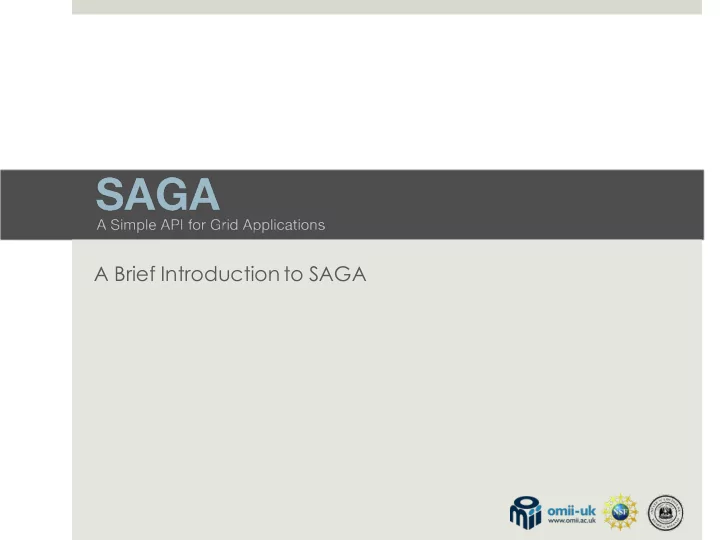

A Brief Introduction to SAGA Building and Installing
All material from this tutorial can be found at: https://svn.cct.lsu.edu/repos/saga-projects/tutorial/EGI-2011
General Information and Documentation General information http://saga. cct.lsu.edu/ Documentation: http://saga.cct.lsu.edu/software/cpp/documentation API documentation Python http://static.saga.cct.lsu.edu/apidoc/python/latest/ C++ http://static.saga.cct.lsu.edu/apidoc/cpp/latest/ Programmers Guide: https://svn.cct.lsu.edu/repos/saga/core/trunk/docs/manuals/prog ramming_guide/tex/saga-programming-guide.pdf TeraGrid SAGA Tutorial November 29, 2010 3
Distributed Applications Development Challenges Developing Distributed Applications is fundamentally hard: Intrinsic: Control/Coordination & execution over Heterogeneous sites Complex Design point/Models of Distributed Applications, Reasons for using distributed CI -- more than (peak) performance result Extrinsic: (Complex) Underlying infrastructure & its provisioning Large number Programming systems, tools and environments Lack of well-defined interfaces & abstractions Interoperability and extensibility become difficult Number of “effective” distributed applications that utilize resources sequentially, concurrently or asynchronously is low Distributed CI: Is the whole > than the sum of the parts? See: DPA Survey Paper: http://www.cct.lsu.edu/~sjha/dpa_publications/dpa_surveypaper.pdf
SAGA: In a nutshell There exists a lack of Programmatic approaches that: Provide general-purpose, basic &common grid functionality for • applications and thus hide underlying complexity, varying semantics.. The building blocks upon which to construct “consistent” higher -levels of • functionality and abstractions Meets the need for a Broad Spectrum of Application: • Simple scripts, Gateways, Smart Applications and Production Grade • Tooling, Workflow… Simple, integrated, stable, uniform and high-level interface Simple and Stable: 80:20 restricted scope and Standard • Integrated: Similar semantics & style across • Uniform: Same interface for different distributed systems • SAGA: Provides Application* developers with units required to compose high-level functionality across (distinct) distributed systems (*) One Person’s Application is another Person’s Tool
SAGA: In a thousand words
SAGA: Architecture
How is SAGA Used? SAGA is used to develop applications that are distributed by definition: Simple extensions of “localized applications” ( eg scripting) MW applications, workers submitted to >8 back-ends Novel Distributed Programming Models (eg Rep-Exch) SAGA: Build tools and implement abstractions that enable the execution of applications over distributed resources, without modifying the applications Eg. Infrastructure Independent Pilot-Jobs SAGA: To provide uniform access layers to heterogeneous CI Uniform access to EGI (ARC, gLite, Globus and Unicore/BES) Simplify the building of tools and Gateways
1. Develop applications that are distributed by definition
Recommend
More recommend